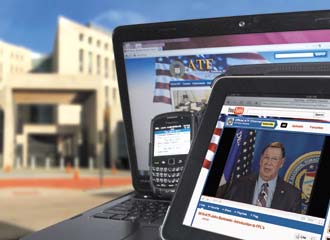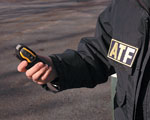When Walls Get in the Way, Bureau Goes Mobile
 |
The Bureau of Alcohol, Tobacco, Firearms and Explosives, a unit of the U.S. Department of Justice, has emerged as a leader in the government’s executive branch when it comes to deploying mobile devices among its personnel. The agency’s law enforcement portfolio has given it an edge as a large portion of its work force already uses laptops and handheld devices for work outside of the Washington, D.C., headquarters.
Driven by a mobile work force, the bureau constantly looks for ways to expand mobility and contain costs. A pilot program uses the Apple iPad to expand mobile deployment options for the bureau’s wide-ranging activities, which include investigations of the illegal manufacture and use of firearms, the illegal sale of alcohol and tobacco, acts of arson and bombings. The iPad initiative is part of the organization’s effort to determine the optimal mix of mobile technology, given the ever-changing landscape of devices.
Because Bureau of Alcohol, Tobacco, Firearms and Explosives (ATF) special agents mostly work outside of their field offices and travel extensively, they must have access to relevant, timely information no matter where they are, explains. Dr. Rick Holgate, the assistant director for science and technology and chief information officer at the ATF. But Holgate allows that deployment of mobile devices in his agency extends not only to special agents in the field, but also to a range of staff members whose jobs either require them to be in the field regularly or who have telework agreements common in other government agencies. Industry regulatory investigators and the professional support staff, many of whom telework, also benefit from the bureau’s mobile edge.
Prior to his arrival at the ATF two years ago, Holgate says his agency already had embarked on an ambitious program to provide mobile computing capability to its staff outside of headquarters using personal laptop computers. The agency was shifting the work force to a much more laptop-oriented mix of user devices to give them the flexibility to work outside the office, he explains. Beyond that, “We also adopted cellular broadband technology, so we provided, within the last couple of years, a lot of Air cards and cellular broadband connectivity.”
The ATF mobile computing strategy recently has been adjusted to include BlackBerry smartphones in the mix of remote-access tools, Holgate explains. They have been issued to field staff “with the understanding that the users can employ their BlackBerrys for cellular data connectivity in conjunction with their laptops. It ended up being a more cost-effective mix of technology, rather than having folks with a cellular broadband card and a BlackBerry.” The smartphones can be tethered to laptops to take advantage of the phones’ data plan, in much the same way that landline modems once were used to provide connectivity to personal computers via the analog telephone network.
Part of the motivation for this current strategy is budgetary, Holgate says, adding, “We consciously made that shift within the last four or five months just to eliminate some of the cellular broadband costs.”
He says those costs count when more than two-thirds of ATF staff members are using some form of mobile computing technology. Across the ATF work force, including contractors and task force officers, there are 7,500 users: approximately 5,000 are employees and about 2,500 are non-employees.
He estimates that the ATF has deployed about 6,500 laptops and about 3,600 BlackBerrys among its staff. A comprehensive budget figure for the overall deployment of mobile technology within the ATF is difficult to calculate because costs for information technology are distributed among the different operational units of the agency.
Deployment of laptops is managed through an outsourced desktop infrastructure provided by an outside vendor. Separate contracting relationships exist with the mobile device providers who handle all the billing and administrative tasks for such functions as cellular usage.
 |
The newest ATF mobile strategy also includes BlackBerry and Apple smartphones, and could expand to the Apple iPad. |
Kathleen Shanahan, CRGT’s vice president for national security and law enforcement, says that the pilot program for the ATF is looking for a “true framework for secure application deployment” of mobile devices, “while supporting new form factors that are introduced into the market.” The idea, she says, is to make agency applications available in a secure manner from anywhere, on any platform, while offering a user-friendly interface and experience.
Unlike the existing BlackBerry-tethered laptops, Shanahan says the pilot her firm is directing will allow iPads to stand on their own. That is because along with Wi-Fi, the iPad also connects independently to the 3G cellular broadband networks.
In addition, she says, the pilot program is designed to give the ATF “the foundation” to support the concept of integrating staff-owned iPads into the agency’s network, while at the same time “maintaining the security of the enterprise data.” This initiative is in keeping with Federal Chief Information Officer Vivek Kundra’s suggestion, voiced earlier this year, that agencies embrace a bring-your-own philosophy by allowing staff to use personal mobile devices to access agency applications and databases for work.
The solution, says Shanahan, is called secure sandboxing. “The sandbox approach allows for logical separation of business and personal applications and data,” she explains, “by creating a FIPS 140-2 validated AES-256 encrypted container” on the device. “This container will host the agency’s verified application. This container will separate the personal applications that might be downloaded from the FISMA [Federal Information Security Management Act] applications provisioned by the agency through their own ‘application store.’”
Shanahan points out that for the moment, most agencies will prefer to issue government-owned iPads for use by staff, but the mobility pilot will give the ATF the option of allowing personal iPads to communicate with the data center in Washington, D.C., once policies and procedures are in place to support the bring-your-own concept. She also adds that the sandbox will enable the agency to deploy appropriate third-party developed applications to, for example, allow an employee to send voice-dictated emails through an ATF enterprise server. They also will allow for full encryption on the device once the message is on its way.
The iPad is an example of a rapidly expanding family of mobile technologies that is moving beyond casual consumer use and instead is being embraced by professionals who want to improve their productivity. Shanahan says that for the ATF mobility pilot program, additional technologies and applications are being used that run “on top of the iOS [Apple iPhone operating system, which also runs the iPad] to meet all the security requirements.” She says that one of her firm’s partners in the pilot, LRW Technologies, provides the mobile device management software that creates the secure sandbox that overcomes the known security vulnerabilities in the device’s operating platform.
Shanahan says this mobility program actually had its genesis in another item in ATF’s mobile computing wish list: the ability to stream full-motion video wirelessly to any mobile device in its fleet. The challenge was in the inherent security shortcomings of both the iPad and Android operating system devices. She says her firm “learned a lot from that, because it’s a balancing act. Not only do you have to ensure security, that’s the number one priority, but you also have to do that without taking away the inherent usability of the device.”
While this mobility program is being conducted and paid for by the ATF, Shanahan says CRGT also is working with an unspecified number of other government agencies with similar needs and concerns about integrating mobile tablets such as the iPad into their computing environments.
Holgate relates that the iPad pilot program is an important step forward. “We’re looking at the iPad, and other tablet-like devices, and looking at evolving smartphone-type capabilities, looking at virtual desktop infrastructure,” he explains. The challenge is to determine which of that evolving set of technologies offers the best mix for users.
One of the biggest hurdles to more widespread adoption of telework in the federal government has come not from top-level cabinet officials, or from rank-and-file staffers, but from mid-level managers, many of whom are accustomed to the security of being able to actually see their employees working away at their desks. But the “Snowpocalypse” of 2010, which brought five-foot deep blizzards to much of the East Coast and closed much of the federal government in the Washington, D.C., metropolitan area for a week, has convinced many in agencies to take a second look at remote access working for staff where appropriate. At the ATF, however, Holgate says such persuasion is unnecessary.
“I’ve heard our deputy assistant director for industry operations say that, ‘If you’re in the office, you’re not working!’” he says. “So, they have a very aggressive approach to most of their work being outside of the office, on-site with our industry partners.”
Holgate explains that much of the enthusiasm for working remotely using portable technology has not come from senior executive leadership, but from, as he puts it, “the working-class GS-13 folks,” who he says have seen how it can help them do their jobs and help them be more effective in their work.
WEB RESOURCES
Bureau of Alcohol, Tobacco, Firearms and Explosives: www.atf.gov/
CRGT: http://crgt.com/




Comments